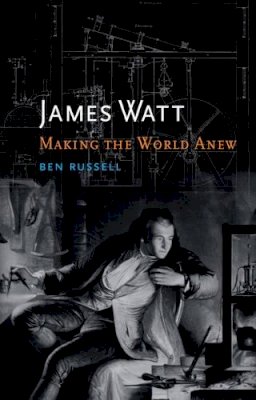
James Watt: Making the World Anew
Ben Russell
This book explores James Watt’s early years and interests, as well as his highly successful 25-year partnership with the industrialist Matthew Boulton. But while traditional biographies of Watt concentrate on the steam engine, James Watt: Making the World Anew tells a richer story: it explores the processes by which ephemeral ideas were transformed into tangible artefacts, and places Watt within the context of Britain’s early industrial transformation. Watt’s work is emblematic of a wider culture of multifaceted artisanship, and this book probes the widely held motivation for making things, looking not only at what was produced but also why. It draws on a rich range of resources – from archival material and biographies on Watt to objects themselves, and sources from fields as diverse as ceramics, antique systems of proportion, sculpture and machine making.
Generously illustrated, James Watt is a unique, expansive exploration of the engineer’s career. His life is used as a lens through which the broader practices of manufacturing in the eighteenth and early nineteenth centuries, and the Industrial Revolution, are explored.
Published in association with the Science Museum, London.
Product Details
About Ben Russell
Reviews for James Watt: Making the World Anew
Isis Journal
The first engineer to be commemorated in Westminster Abbey, Watt was long celebrated as a heroic figure who arrived at his epochal discoveries by virtue of lonely genius. Ben Russell helps correct that picture by celebrating Watt as a doer and a maker, rooted in the artisanal culture of his times. Steeped in scholarship, as well as nitty-gritty knowledge of the artefacts of the Industrial Revolution, James Watt: Making the World Anew will prove fascinating to anyone who wants to know how and why steam engines were made.
TLS
In 1924, Londons Science Museum acquired the entire workshop of engineer James Watt, left almost untouched in the attic of his house in Birmingham since his death more than a century before. The museum put a recreation of the workshop on permanent display in 2011. This workshop inspired Ben Russell, the Science Museums curator of mechanical engineering, to write his engaging James Watt: Making the World Anew . . . The diversity of Watts interests and activities was astonishing, even when compared with the achievements of his Enlightenment contemporaries.
Nature
Celebrated for his industrial inventions, Watt himself now belongs to Britains heritage industry. Russell has provided a refreshingly original insight into the life and activities not only of this national hero, but also of his many less famous colleagues who together transformed traditional craftsmanship into industrial innovation.
British Journal for the History of Science
Russell moves beyond the steam engine to look at Watts many other pioneering inventions.
The Observer
comprehensive and well-researched . . . [a] generous and fascinating collection of illustrations . . . With a sure touch, Ben Russell makes it clear that there was far more to Watt than steam and steam engines.
Methodist Recorder
Many more examples could be given, such is the richness of this book, many more than can be mentioned in a short review . . . Russell supports his ideas with copious references, both from the literature of Watts own day, as well as others from scholars of today. These cover an enormous range of sources which strengthen Russells arguments and compel us to think seriously about the themes he proposes.
International Journal for the History of Engineering & Technology
Russell’s use of Watt as a lens for exploring Industrial Revolution Britain is effective, providing an interesting personal perspective on the larger themes of the period . . . Russell’s emphasis on the impact that craftsmen had in shaping industrial developments is an interesting addition . . . the work will be welcome by readers interested in Watt or popular scientific histories. The work would be an effective companion text for a course on Industrial Revolution Britain, as it provides a personal perspective on the wider topic. Ultimately, it illustrates how scientific research is directed by personal experience and larger social influences.
Richard M. Mikulski, Drew University
Nineteenth Century Studies Journal
